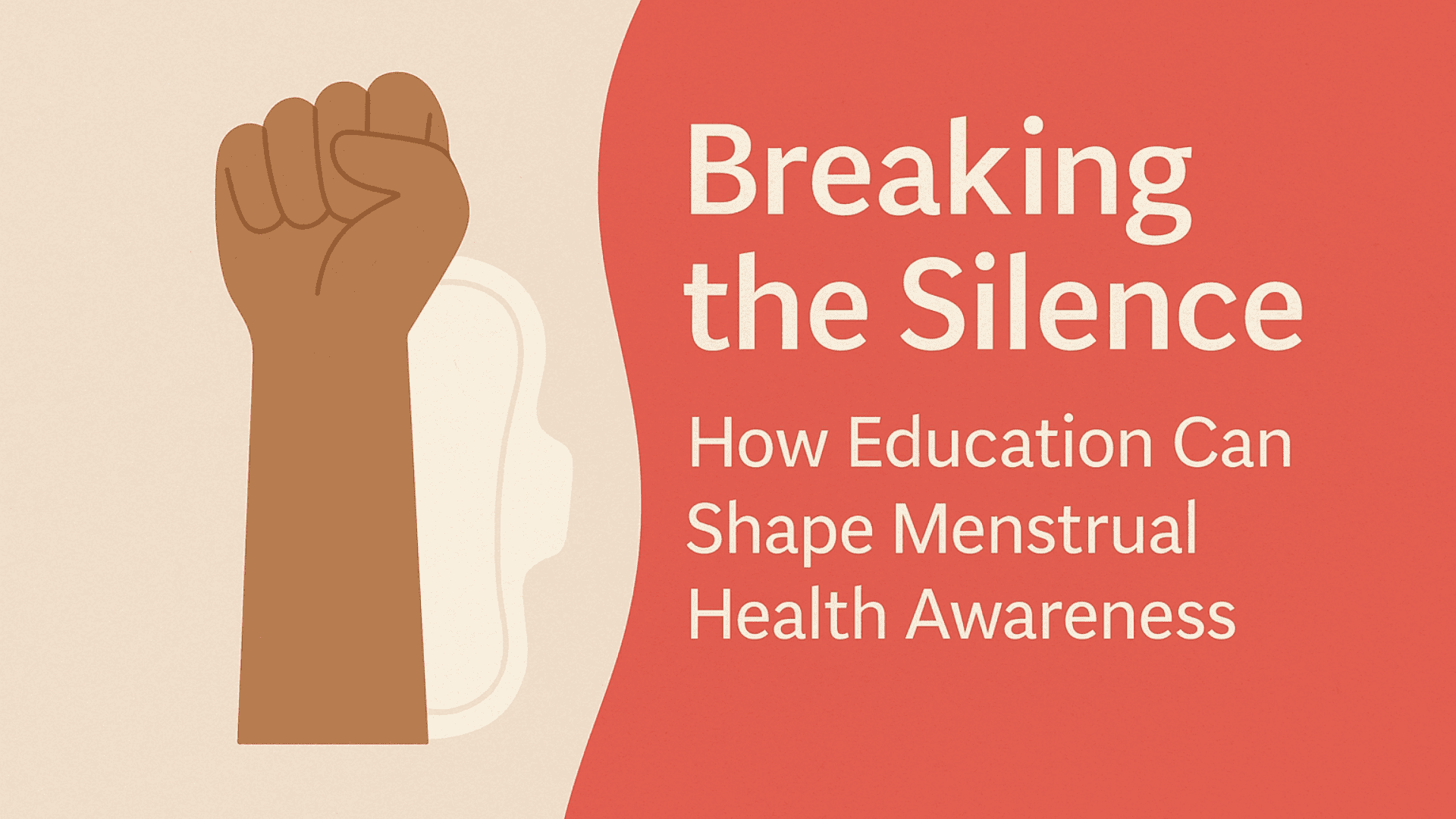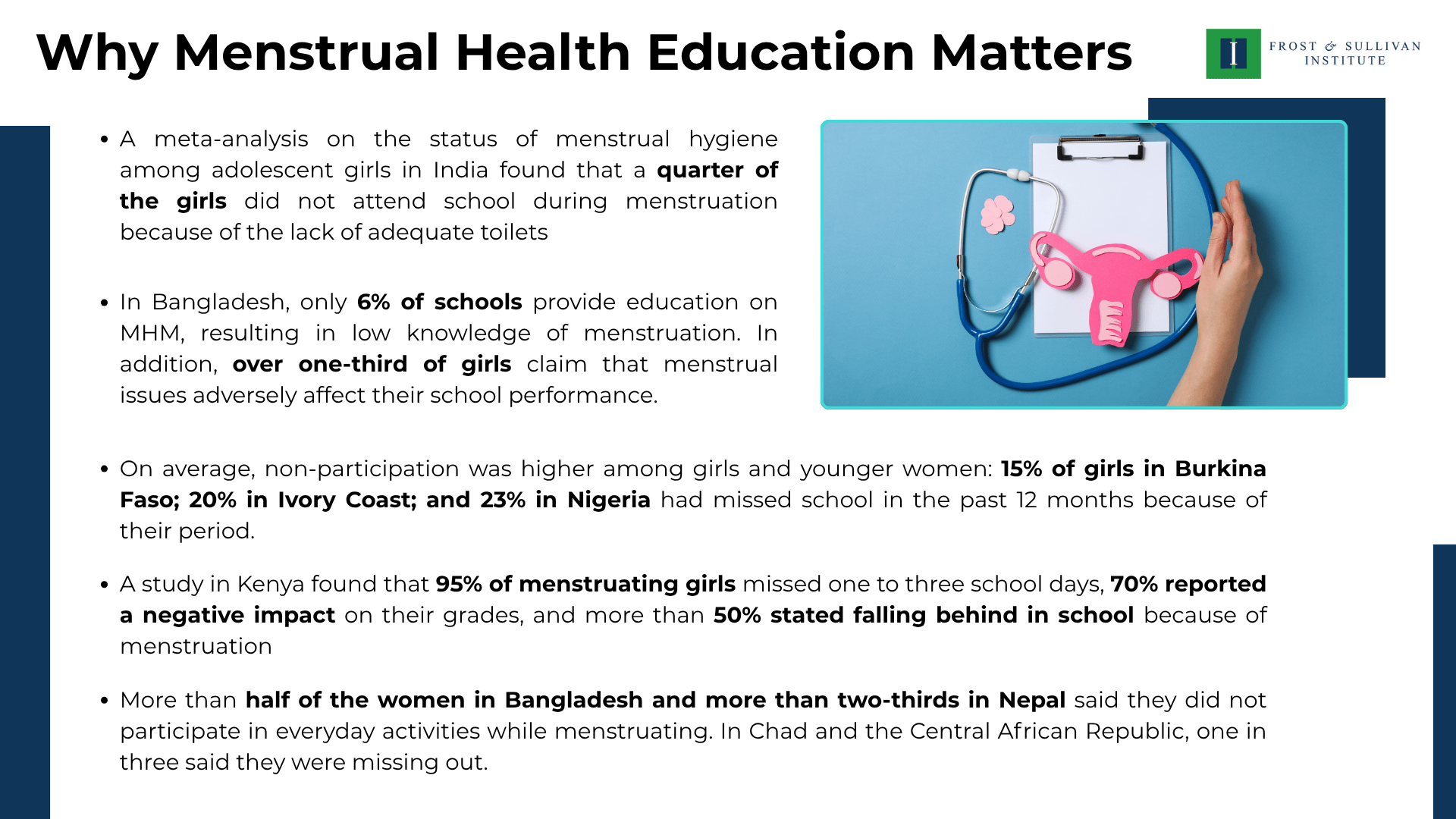
16 Jul Breaking the Silence: How Education Can Shape Menstrual Health Awareness
In many classrooms around the world, an important subject is still left untaught, not by choice, but by discomfort, stigma, and silence. That subject is menstrual health. While millions of girls attend schools every day, a large number do so without any knowledge about menstruation, a natural biological process that affects nearly half the global population. In some parts of the world, the first experience of menstruation is not only frightening but also isolating, because of myths and shame. The lack of education around menstrual health is a barrier to education, dignity, and equality.
The Global Status of Menstrual Health Awareness in Schools
Globally, menstrual health education remains inadequate. According to UNICEF, on any given day, more than 300 million women worldwide are menstruating and in total, an estimated 500 million lack access to menstrual products and adequate facilities for menstrual hygiene management (MHM), which includes the knowledge, products, and facilities to manage their periods safely and with dignity. In countries like Ethiopia and Bangladesh, fewer than half of girls know about menstruation before they experience it. Even in more developed countries, menstrual education is often delayed, incomplete, or treated as an awkward afterthought in biology classes.
In low- and middle-income countries (LMICs), the lack of education about menstruation is compounded by infrastructural and cultural barriers. Girls are often told to stay home during their periods. They use unhygienic materials, are shamed for bleeding, and often grow up believing menstruation is something dirty or wrong. According to a study titled “Menstrual Hygiene Preparedness Among Schools in India,” less than half of the girls were aware of menstruation before menarche, teachers were a less common source of information about menstruation to girls, and separate toilets for girls were present in around half of the schools. This reflects a gap in the education system and infrastructure to educate young girls about menstruation.
Key Statistics on Menstrual Health in Schools
- Only 39% of schools worldwide offer menstrual health education, which rises to 84% in secondary schools in Central/Southern Asia but stays at just 34% in primary schools. (UNICEF, 2024)
- Less than 31% of girls’ toilets globally have dedicated bins for menstrual waste. In Least Developed Countries, it’s only 17%, and in sub-Saharan Africa, a mere 11%. (WHO, 2024)
- Only 12% of schools in sub-Saharan Africa provide menstrual supplies, whether free or for purchase.
- In Northeast Ethiopia, 54.5% of schoolgirls missed 1–4 days each menstrual period. 82% cited fear of leakage, 56% lack of pads, and 31% absence of private facilities as reasons. (UNICEF 2024)
- In rural Nepal, 84% of menstruating students missed school, averaging 2.6 days over three months, primarily due to pain and fear of staining. (IWA 2022)
- Less than half of girls knew about menstruation before menarche in Ethiopia, and 50% miss school monthly in some regions. (World Bank 2022)
Why Menstrual Health Education Matters
Menstrual health is directly linked to a girl’s self-esteem, health, and access to education. Poor menstrual hygiene can lead to infections, reproductive tract diseases, and mental health challenges such as anxiety and shame. In India, a study by WaterAid found that over 23% of girls drop out of school when they reach puberty, primarily due to lack of awareness, toilets, and sanitary products.
The consequences of ignoring menstrual health in school settings are long-lasting. Girls missing 3–5 days of school each month fall behind in their studies. And without education, boys remain unaware, reinforcing stigma and sometimes bullying those who menstruate.

The Awareness Gap
Despite its importance, menstrual health is rarely discussed openly in most schools. Teachers feel uncomfortable, curricula lack proper content, and cultural taboos often discourage open dialogue. In many countries, girls receive their first information from peers or mothers, who themselves may hold misconceptions. Boys are excluded entirely from the conversation, deepening the stigma. And only 13% of girls in India, according to UNICEF, are aware of menstruation before their first period. This lack of knowledge isn’t just a personal issue; it’s systemic.
How Education Can Close the Gap
Schools are uniquely positioned to normalize menstruation and empower students with accurate, shame-free knowledge. The solution requires more than just pad distribution; it requires an ecosystem of support. Here’s how education can close the menstrual health gap:
- Comprehensive Menstrual Health Curriculum
Age-appropriate menstrual education starting before menarche is crucial. Lessons should include biology, hygiene, emotional changes, and cultural sensitivity. Importantly, boys must be included to reduce stigma and foster understanding. - Training Teachers and Health Workers
Many educators themselves feel unequipped to handle menstrual discussions. Training and sensitization can turn teachers into trusted mentors rather than silent observers. - Infrastructure and Access
Menstrual health education must be supported by clean toilets, access to sanitary products, disposal mechanisms, and water. A classroom discussion alone cannot succeed if girls lack the physical resources to manage their periods. - Involvement of Parents and Communities
Schools should act as community hubs to engage mothers, fathers, and local leaders. Creating a culture of openness around menstruation can break taboos that extend beyond school gates.
Menstrual health should not be a luxury, a whisper, or a source of shame; it should be part of every school’s commitment to student wellbeing. As classrooms become more inclusive and progressive, the silence around periods must end. By embedding menstrual education into the curriculum, equipping teachers, improving infrastructure, and empowering students to speak openly, we can turn a source of stigma into a symbol of strength.
Case Study:
In Nepal, menstrual health has historically been shrouded in silence, stigma, and misinformation, factors that have had a significant impact on the education and well-being of adolescent girls. Recognizing the link between menstrual hygiene management (MHM) and school attendance, the Government of Nepal took a bold policy step in the fiscal year 2019/20 by launching a national initiative to provide free sanitary pads to girls in public schools. This intervention, spearheaded by the Ministry of Education, Science and Technology (MoEST), was rooted in a broader commitment to promoting gender equity in education and ensuring that menstruation would no longer be a reason for girls to miss school.
The program targeted girls in grades 6 to 10 across public schools, distributing disposable sanitary pads every month. With an initial budget allocation of over NPR 1.3 billion, the initiative sought to address both practical and psychological barriers related to menstruation. On average, each girl received 16 sanitary pads per month, a move designed not just to meet basic hygiene needs, but to affirm the message that menstruation is a normal biological process deserving of institutional support.
This government-led initiative was complemented by the efforts of civil society organizations such as WaterAid Nepal, Restless Development, and Plan International Nepal, which conducted menstrual health awareness campaigns in schools and communities. These organizations played a crucial role in educating both students and teachers about menstruation, hygiene practices, and dignity. In some districts, they also facilitated the installation of girl-friendly toilets, disposal bins, and even trained girls in making reusable sanitary pads further reinforcing sustainable practices.
Early outcomes of the program indicated positive change. Reports from several districts showed a decline in menstruation-related absenteeism among adolescent girls. Beyond attendance, the initiative also began to break the culture of silence. With increased awareness sessions and teacher involvement, girls started to feel more comfortable discussing menstruation, both in schools and at home. Female teachers, in particular, were instrumental in creating safe spaces for these conversations, helping girls manage their periods with greater dignity and confidence.
However, the program has not been without its challenges. Distribution gaps in remote areas, lack of proper disposal systems, and uneven access to gender-sensitive sanitation infrastructure limited its impact in certain regions. Moreover, while sanitary pads were distributed, comprehensive MHM education remained inconsistent, leaving gaps in knowledge and perpetuating some cultural taboos.
Despite these limitations, the free sanitary pad distribution program marks a significant milestone in Nepal’s journey toward menstrual equity. By institutionalizing menstrual health within the public education system, the government sent a strong signal that girls’ health and education are not secondary concerns, but central to the nation’s development. The intervention laid the foundation for deeper conversations about dignity, gender rights, and bodily autonomy, and it remains a model for how policy can be leveraged to address deeply rooted social issues.
As the initiative continues to evolve, stakeholders emphasize the importance of integrating menstrual health into the broader school health curriculum, improving WASH (water, sanitation, and hygiene) infrastructure, and encouraging greater male engagement in menstrual education. With these steps, Nepal can move closer to a future where menstruation no longer hinders a girl’s ability to learn, grow, and thrive.
Blog by Shreya Ghimire,
Research Analyst, Frost & Sullivan Institute
